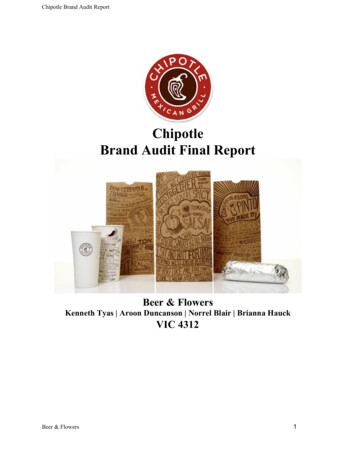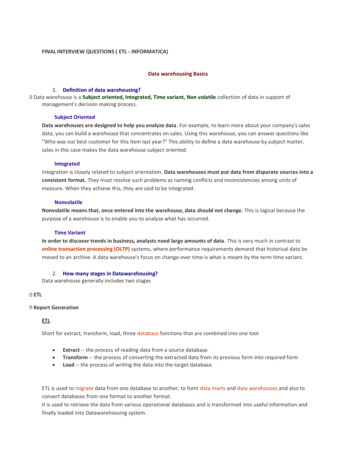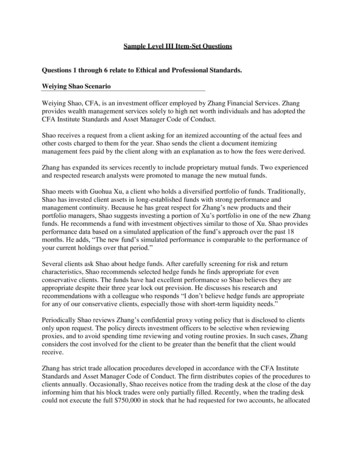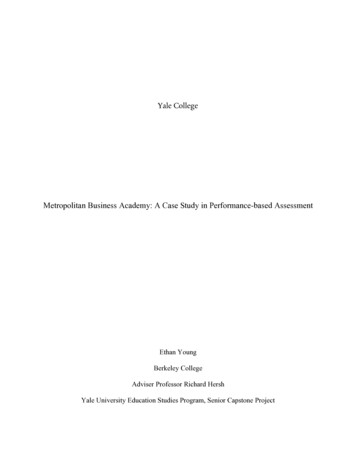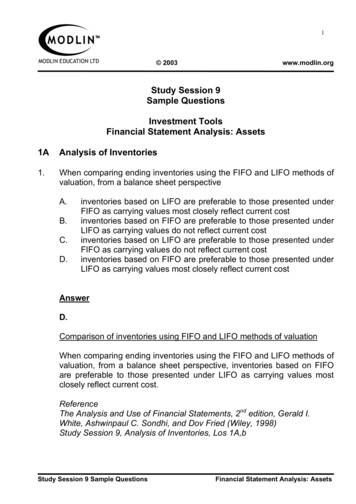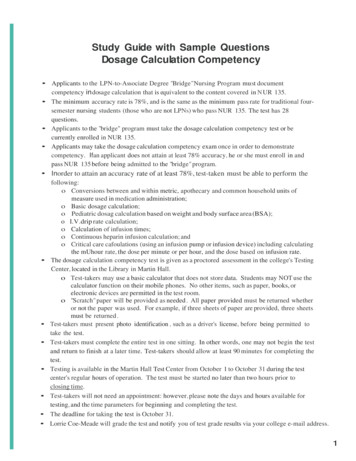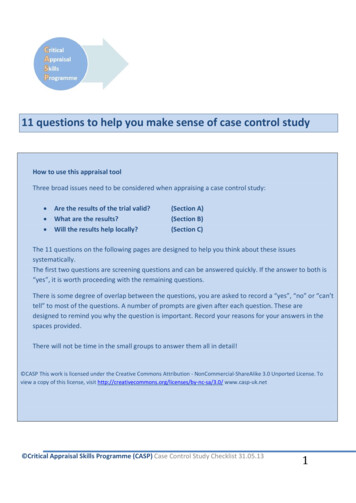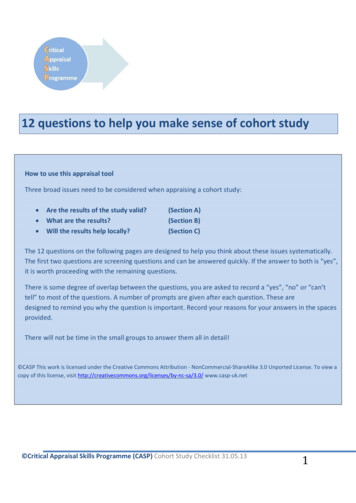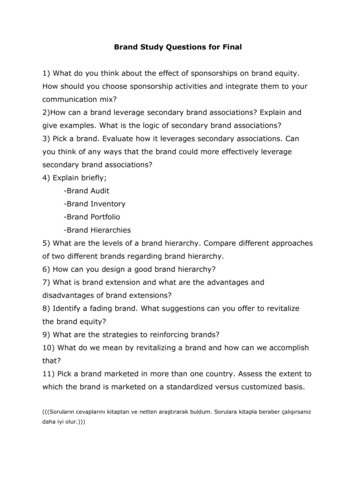
Transcription
Brand Study Questions for Final1) What do you think about the effect of sponsorships on brand equity.How should you choose sponsorship activities and integrate them to yourcommunication mix?2)How can a brand leverage secondary brand associations? Explain andgive examples. What is the logic of secondary brand associations?3) Pick a brand. Evaluate how it leverages secondary associations. Canyou think of any ways that the brand could more effectively leveragesecondary brand associations?4) Explain briefly;-Brand Audit-Brand Inventory-Brand Portfolio-Brand Hierarchies5) What are the levels of a brand hierarchy. Compare different approachesof two different brands regarding brand hierarchy.6) How can you design a good brand hierarchy?7) What is brand extension and what are the advantages anddisadvantages of brand extensions?8) Identify a fading brand. What suggestions can you offer to revitalizethe brand equity?9) What are the strategies to reinforcing brands?10) What do we mean by revitalizing a brand and how can we accomplishthat?11) Pick a brand marketed in more than one country. Assess the extent towhich the brand is marketed on a standardized versus customized basis.(((Soruların cevaplarını kitaptan ve netten araştırarak buldum. Sorulara kitapla beraber çalışırsanızdaha iyi olur.)))
1) What do you think about the effect of sponsorships on brandequity. How should you choose sponsorship activities andintegrate them to your communication mix? To identify with a particular target market or lifestyle: Marketers can linktheir brands to events popular with either a select or broad group ofconsumers. They can target customers geographically, demographically,psychographically, or behaviorally, according to the sponsored events. To increase awareness of the company or product name: Sponsorshipoften offers sustained exposure to a brand, a necessary condition tobuilding brand recognition. By skillfully choosing sponsorship events oractivities, marketers can enhance identification with a product and thusalso brand recall. To create or reinforce consumer perceptions of key brand imageassociations: Events themselves have their own associations that help tocreate or reinforce brand associations. To enhance corporate image dimensions: Sponsorship is a soft sell and ameans to improvent perceptions that the company is likable, prestigious,and so forth. Marketers hope consumers will credit the company for itssponsorship and favor it in later product choices. To create experiences and evoke feelings: Events can be part of anexperiential marketing program. The feelings engendered by an excitingor rewarding event may indirectly link to the brand. Marketers can alsouse the Web to provide further event support and additional experiences. To express commitment to the community or on social issues: Oftencalled cause-related marketing, sponsorships dedicated to the communityor to promoting social issues create corporate tie-ins with nonprofitorganizations and charities (see Chapter 11). For over 20 years, Colgate-
Palmolive has sponsored the Starlight Children’s Foundation, which grantswishes to young people who are critically ill. To entertain key clients or reward key employees: Many events havelavish hospitality tents and other special services or activities that areavailable only for sponsors and their guests. Bank of Boston’s sponsorshipof musical performances and Bank of America’s golf tournamentsponsorship include special events for clients. Involving clients with theevent in these and other ways can engender goodwill and establishvaluable business contacts. From an employee perspective, events canbuild participation and morale or create an incentive. To permit merchandising or promotional opportunities: Many marketerstie in contests or sweepstakes, in-store merchandising, and directresponse or other marketing activities with their event. Warner-Lambertsponsors the “Taste of Chicago” promotion in part so it can gain shelfspace in stores and participate in retailer co-op advertising.2)How can a brand leverage secondary brand associations?Explain and give examples. What is the logic of secondary brandassociations?Secondary brand associations may be quite important to creating strong,favorable, and unique associations or positive responses if existing brandassociations or responses are deficient in some way. It can also be aneffective way to reinforce existing associations and responses in a freshand different way.we can leverage secondary brand associations by linking the brand to thefollowing:1. Companies (through branding strategies)2. Countries or other geographic areas (through identification of productorigin)3. Channels of distribution (through channel strategy)
4. Other brands (through co-branding)5. Characters (through licensing)6. Spokespersons (through endorsements)7. Events (through sponsorship)8. Other third-party sources (through awards or reviews)3) Pick a brand. Evaluate how it leverages secondary associations.Can you think of any ways that the brand could more effectivelyleverage secondary brand associations?Let’s choose BMW as a company. When BMW generates a new carthat name is “BMW-Exclusive X” . People see this and they inference likethat “Did you see the new car of BMW, it must be safe, strong” etc etc.This is company effect on brand equity.Country of origin is also important. When people buy a car theyconsider its origin country and when we think our example, BMW is aGerman car. Germany is the pioneer in car industry. This providesconsiderable advantages to the company.Channels of distribution is also important. A consumer may infercertain characteristics about a brand on the basis of where it is sold. Forexample when we buy a smart phone, we generally choose “SamsungStore, Apple Store” I mean we don’t buy the smart phone from a streetvendor. If the smart phone is sold in a store like I mentioned before,people think this product should be good quality. Consider these in ourBMW example.Co-branding provides some advantages to BMW. Suppose that BMWcombines with Mercedes-Benz. This would generate greater sales thanbefore. This combination can reduce the cost of product introductionbecause it combines two well known images. We can say countlessadvantages to this.Licensed character could be effectively leveraged for BMW. BMW canfind some licensed characters like Vin Diesel. The rationale behind these
strategy is that a famous person can draw attention to a brand and shapethe perceptions of the brand. On the other hand when BMW generates anew designed car, nobody can generate this type of car withoutpermission of BMW. Because Licensing provides legal protection fortrademarks.(Step 5 and 6)Sponsored events can contribute to brand equity by becomingassociated to the brand and improving brand awareness, adding newassociations, or improving the strength, favorability, and uniqueness ofexisting associations. Suppose that BMW will be the sponsor of Formula 1.Finally, marketers can create secondary associations in a number ofdifferent ways by linking the brand to various third-party sources.Suppose that new BMW car is introduced in a car magazine.4) Explain briefly;-Brand AuditIn the most general terms, a brand audit is a detailed analysis of yourbrand in its current state. By determining which qualities of your brandare currently effective and which ones are not, you can restructure youridentity and your messaging goals to produce better results.A brand audit: Assesses how well the brand is delivering against the company’sobjectives Identifies customer wants, needs, and trends at the category level Inventories and categorizes all existing brand elements and assets(trademarks, sub-brands, logos, taglines) in the brand portfolio Describes relevant competitive market trends and your brand’sstrengths/weaknesses Evaluates the brand’s current image (how it isperceived by customers and other key stakeholders) Identifies potentialsources of differentiation, tablestakes, vulnerabilities
-Brand InventoryThe purpose of the brand inventory is to provide a current,comprehensive profile of how all the products and services sold by acompany are marketed and branded. Profiling each productor service requires marketers to catalogue the following in both visual andwritten form for each product or service sold: the names, logos, symbols,characters, packaging, slogans, or other trademarks used; the inherentproduct attributes or characteristics of the brand; the pricing,communications, and distribution policies; and any other relevantmarketing activity related to the brand.-Brand PortfolioWhen large businesses operate under multiple different brands, servicesand companies, a brand portfolio is used to encompass all these entitiesunder one umbrella. Often, each of these brands has its own separatetrademarks and operates as an individual business entity. However, formarketing purposes, a brand portfolio is used to group them all together.Brand portfolios are also used to lessen consumer confusion in regard towho owns particular brands. For example, consider PepsiCo. PepsiCo is thebrand portfolio name of several food and beverage companies that includenot only Pepsi, but also brands such as Frito Lay, Quaker and Tropicana.-Brand HierarchiesA brand hierarchy is a useful means of graphically portraying a firm’sbranding strategy by displaying the number and nature of common anddistinctive brand elements across the firm’s products, revealing theirexplicit ordering. It’s based on the realization that we can brand a productin different ways depending on how many new and existing brandelements we use and how we combine them for any one product.For example, a Dell Inspiron 17R notebook computer consists of threedifferent brand name elements, “Dell,” “Inspiron,” and “17R.” Some of
these may be shared by many different products; others are limited. Delluses its corporate name to brand many of its products, but Inspirondesignates a certain type of computer (portable), and 17R identifies aparticular model of Inspiron (designed to maximize gaming performanceand entertainment and including a 17- inch screen).5) What are the levels of a brand hierarchy. Compare differentapproaches of two different brands regarding brand hierarchy.Levels of a Brand HierarchyDifferent levels of the hierarchy have different issues, as we review inturn.Corporate or Company Brand Level.is the practice of using a company’s name as a product brand name. It isan attempt to use corporate brand equity to create brand recognition.Example: IBM, Coca Cola.Family Brand Level.The marketing strategy of family branding, or umbrella branding, involvesmarketing and selling your product lines using a single brand name.AppleApple works under a family, or umbrella branding strategy. The use of onebrand name and the recognizable Apple logo make it easy for customersto find and identify Apple products. Within the family brand, thecorporation markets computers, phones, accessories, music players andtablets. The family branding Apple uses helps the company's managementcontrol costs by saving on new logo and brand name development costsIndividual Brand LevelIt is a marketing strategy of branding different products by differentnames. Such a branding strategy helps establish a unique brand identity,image and positioning. Also, if one brand fails in the market or is
perceived to be of low quality, it does not have a ripple effect on the otherproduct categories.Example: Head&Shoulders, Rejoice, Pantene, Gillette.Modifier LevelModifier refers to word, phrase or clause that functions as an adjective oradverb to qualify the meaning of other word. Regardless of whethercorporate, family or individual brands are employed it is often necessaryto further distinguish brand according to the different types of items ormodels involved.(Mesela bir ürünün belli başlı kendine has özellikleriyle ön plana çıkması, Yoplait markayoğurdun hafif olmasıyla, kendine has bir sosu ve orijinal lezzetiyle kendini müşterilerinesunması)Product Descriptor.The product descriptor helps consumers understand what the product isand does and also helps define the relevant competition in consumers’minds.6) How can you design a good brand hierarchy?a. Decide on which products are to be introduced. Principle of growth: Invest in market penetration or expansion vs.product development according to ROI opportunities. Principle of survival: Brand extensions must achieve brand equity intheir categories. Principle of synergy: Brand extensions should enhance the equity of theparent brand.b. Decide on the number of levels. Principle of simplicity: Employ as few levels as possible. Principle of clarity: Logic and relationship of all brand elementsemployed must be obvious and transparent.
c. Decide on the levels of awareness and types of associations tobe created at each level. Principle of relevance: Create abstract associations that are relevantacross as many individual items as possible. Principle of differentiation: Differentiate individual items and brands.d. Decide on how to link brands from different levels for a product. Principle of prominence: The relative prominence of brand elementsaffects perceptions of product distance and the type of image created fornew products.e. Decide on how to link a brand across products. Principle of commonality: The more common elements products share,the stronger the linkages.7) What is brand extension and what are the advantages anddisadvantages of brand extensions?Brand Extension is the use of an established brand name in new productcategories. This new category to which the brand is extended can berelated or unrelated to the existing product categories. Arenowned/successful brand helps an organization to launch products innew categories more easily. For instance, Nike’s brand core product isshoes. But it is now extended to sunglasses, soccer balls, basketballs, andgolf equipm
Brand Study Questions for Final 1) What do you think about the effect of sponsorships on brand equity. How should you choose sponsorship activities and integrate them to your communication mix? 2)How can a brand leverage secondary brand associations? Explain and give examples. What is the logic of secondary brand associations? 3) Pick a brand. Evaluate how it leverages secondary associations. Can


